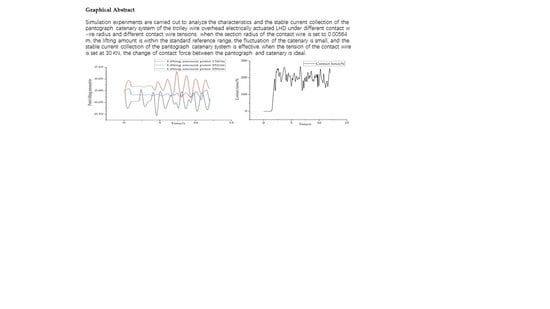Dynamic Performance Simulation and Stable Current Collection Analysis of a Pantograph Catenary System for Trolley Wire Overhead Electrically Actuated LHD
Abstract
1. Introduction
2. Current Collection Principle and Finite Element Simulation Process of the Pantograph Catenary System of Trolley Wire Overhead Electrically Actuated LHD
3. Finite Element Modeling of the Pantograph Catenary System
3.1. A Finite Element Model of the Pantograph in the Pantograph Catenary System
3.2. Finite Element Model of the Catenary System in the Pantograph Catenary System
3.3. The Finite Element Model of the Pantograph Catenary System
4. Simulation Experiment and Results Comparison Analysis
4.1. Analysis of the Influence of the Contact Wire Radius on the Stable Current Collection of the Pantograph Catenary System
4.2. Analysis of the Influence of Contact Wire Tension on the Stable Current Collection of the Pantograph Catenary System
5. Conclusions
Author Contributions
Funding
Conflicts of Interest
Nomenclature
| L1 | Lower arm AD and length |
| L2 | The length of DQ on the upper frame |
| L3 | The length of CD on the upper frame |
| L4 | The length of BC |
| L5 | The length between AE |
| L6 | The length of balance bar EF |
| L7 | The length of the bow QF |
| a | The longitudinal distance between the two points A and B |
| b | The lateral distance between the two points A and B |
| c | The angle between DQ and CD |
| g | The angle between AE and AD |
| The bending stiffness of the contact wire | |
| The tension of the contact wire | |
| The unit mass of the contact wire | |
| The displacement of the contact wire | |
| The bending stiffness of the bearing cable | |
| The tension of the bearing cable | |
| The unit mass of the bearing cable | |
| The displacement of the bearing cable | |
| The impact function | |
| The stiffness of the hanging string | |
| The equivalent stiffness of the positioning device | |
| The contact force between pantograph and catenary | |
| The position of the scraper | |
| The distance of the hanging string from the moving point | |
| The distance from the positioning point to the moving point | |
| The displacement at the positioning | |
| T | Offline time between pantograph and catenary |
| S | Offline rate between pantograph and catenary |
References
- Su, X.J. Application and Development of LHDs in China. MIining Res. Dev. 2006, 26, 89–92. [Google Scholar] [CrossRef]
- Machedon-Pisu, M.; Borza, P. Are Personal Electric Vehicles Sustainable? A Hybrid E-Bike Case Study. Sustainability 2020, 12, 23. [Google Scholar] [CrossRef]
- Turoń, K.; Kubik, A.; Chen, F. Operational Aspects of Electric Vehicles from Car-Sharing Systems. Energies 2019, 12, 4614. [Google Scholar] [CrossRef]
- Kaboli, A.; Carmichael, D. Optimum scraper load time and fleet size for minimum emissions. Int. J. Constr. Manag. 2014, 14, 209–226. [Google Scholar] [CrossRef]
- Wei, S.G.; Bian, R.L. Development and Application of Jin-0.4 Electric LHD. Metal Mine. 2003, 23, 42–43. [Google Scholar] [CrossRef]
- Wang, J.Y. Discussion on the feasibility of using of electric LHD in Tieshan Mine. Nonferrous Met. 2016, 68, 21–23. [Google Scholar]
- Li, H.Z. Improvement of Cable Roller Support for WJD-0.75 Electric Scraper. Copper Eng. 2018, 6, 87–88, 101. [Google Scholar] [CrossRef]
- Chang, L.X. Research on Match of Driveline of Electrically Actuated LHD. Master’s Thesis, Lanzhou University of Technology, Lanzhou, China, 2012. [Google Scholar]
- Bu, Q.F.; Shi, G.L. TORO1400E Electric LHD Cable Reeling System Analysis. Coal Mine Mach. 2015, 36, 53–54. [Google Scholar] [CrossRef]
- Yue, H.B. Comparisons of Three Types of Rolling Cable Guide Devices for Electrically Actuated LHD. Min. Mach. 2014, 42, 139–141. [Google Scholar] [CrossRef]
- Xu, Y.; Zhang, W.X. The control strategy research of the electric LHD’s roll-cable devise. Mach. Des. 2005, 24, 24–26. [Google Scholar] [CrossRef]
- Sui, F.R. Research and Improvement on Warping System of Sandvik Electrical Scraper. Mech. Eng. Autom. 2018, 4, 122–123. [Google Scholar] [CrossRef]
- Li, Q.Y.; Qin, H.B. Research and Design of a Trolley Type Electric Scraper. Constr. Mach. Equip. 2007, 38, 24–28. [Google Scholar] [CrossRef]
- Zhou, Y. Research on Power Supply Protection System of Direct Current Trolley in Mining Electric Locomotive. Shanxi Coking Coal Sci. Technol. 2015, 1, 21–24. [Google Scholar] [CrossRef]
- Wu, B.L. Study on Application of frequency control technology in mine trolley locomotive. Shandong Coal Sci. Technol. 2015, 7, 91–92. [Google Scholar] [CrossRef]
- Han, Y.Y.; Zhang, Z.G.; Zhu, K.G. An Improved Design of the Cable Arrangement Device for the Electric Scooptram. J. Liaoning Inst. Sci. Technol. 2016, 18, 20–22. [Google Scholar] [CrossRef]
- Wu, J.B. Structural design of flexible cable winding device of the electrically actuated LHD. Nonferrous Met. 2000, 5, 29–32. [Google Scholar] [CrossRef]
- Yao, R.; Huang, X.B. Analysis of Finite Element Modeling of Overhead Conductor. Sci. Technol. Inf. 2013, 24, 103–104. [Google Scholar] [CrossRef]
- Liu, W.X.; Liu, Y.C.; Niu, S.Y.; Liu, Z.Q. Assessment Method for Substation Capacity Credit of Generalized Power Source Considering Grid Structure. Sustainability 2017, 9, 928. [Google Scholar] [CrossRef]
- Chen, Z.H.; Shi, Y.L.; Shi, G.; Wang, Z.Y.; Kang, L.Q. Calculation Model of the Contact resistance between Pantograph Slide and Contact Wire. Trans. China Electrotech. Soc. 2013, 28, 188–195. [Google Scholar] [CrossRef]
- Wu, G.; Gao, G.; Wei, W.; Yang, Z. Electrical Contact of Pantograph and Catenary System. In The Electrical Contact of the Pantograph-Catenary System; Springer: Berlin/Heidelberg, Germany, 2019; Volume 4, pp. 978–981. [Google Scholar]
- Jung, S.; Kim, Y.; Paik, J.; Park, T. Estimation of Dynamic Contact Force Between a Pantograph and Catenary Using the Finite Element Method. J. Comput. Nonlinear Dyn. 2012, 7, 41006–41019. [Google Scholar] [CrossRef]
- Song, H.L.; Wu, J.Y.; Wu, Y.; Zheng, J.H.; Zheng, Q.L. Influence of Aerodynamic to High Speed Pantograph Current Collection Characteristics. Electr. Railw. 2010, 21, 28–32. [Google Scholar] [CrossRef]
- Rauter, F.; Pombo, J.; Ambrosio, J.; Chalansonnet, J.; Bobillot, A.; Pereira, M. Contact Model for The Pantograph-Catenary Interaction. J. Syst. Des. Dyn. 2007, 3, 447–457. [Google Scholar] [CrossRef]
- Su, Y.C. On the contradiction between catenary and pantograph. Opencast Mining Technol. 2012, 6, 55–57. [Google Scholar] [CrossRef]
- Kia, S.; Bartolini, F.; Mabwe, A.; Ceschi, R. Pantograph-catenary interaction model comparison. In Proceedings of the IECON 2010-36th Annual Conference on IEEE Industrial Electronics Society, Glendale, AZ, USA, 7–10 November 2010. [Google Scholar]
- Alberto, A.; Benet, J.; Arias, E.; Cebrian, D.; Rojo, T.; Cuartero, F. A high performance tool for the simulation of the dynamic pantograph–catenary interaction. Math. Comput. Simul. 2008, 79, 652–667. [Google Scholar] [CrossRef]
- Zhao, S.P.; Zhang, C.R.; Zhang, Y.P.; Wang, S.H. Influence of Partial Arc on Electric Field Distribution of Insulator Strings for Electrified Railway Catenary. Energies 2019, 12, 3295. [Google Scholar] [CrossRef]
- Guan, J.F.; Wu, J.Q. Finite element analysis of pantograph-catenary dynamic interaction. Arch. Transp. 2016, 39, 77–85. [Google Scholar] [CrossRef]
- Zdziebko, P.; Uhl, T. Investigations on the effects of friction modeling in finite element simulation of machining. Int. J. Mech. Sci. 2010, 52, 31–42. [Google Scholar] [CrossRef]
- Zhao, F. Dynamic Performance Simulation Based on a Pantograph-Catenary System of High-Speed Railway and Analysis Based on the Finite Element Method. Master’s Thesis, Southwest Jiaotong University, Chengdu, China, 2014. [Google Scholar]
- Zhao, F.; Liu, Z.G.; Zhang, X.X. Simulation of High-speed Pantograph-catenary System Dynamic Performance Based on Finite Element Mode. J. China Railw. Soc. 2012, 34, 33–38. [Google Scholar] [CrossRef]
- Zhou, S.; Zhu, Z.R.; Jia, F. Optimization design of pantograph structure parameters for subway trains. Mech. Electr. Inf. 2015, 15, 150–153. [Google Scholar] [CrossRef]
- Jia, H.L.; Zhao, Y.H.; Zhou, Y.M.; Song, Y. Research and Analysis of the Structural Strength of Pantograph. Railw. Locomot. Car 2018, 38, 29–31. [Google Scholar] [CrossRef]
- Chen, K. Study of 3D Multi-body Dynamics Model of Pantograph for Electric Locomotive. Electr. Drive Locomot. 2006, 5, 11–14. [Google Scholar] [CrossRef]
- Zhou, N.; Zhang, W.H.; Wang, D. Lumped Mass Model for Dynamic Performance Simulation of Pantograph. J. Southwest Jiaotong Univ. 2011, 46, 398–403. [Google Scholar] [CrossRef]
- Yu, S.J.; Yang, J.; Fang, Y.; Chen, X.L. On Equivalent Mass of Urban Rail Transit Vehicle’s Pantograph. Urban Mass Transit 2010, 13, 39–41. [Google Scholar] [CrossRef]
- Benet, J.; Cuartero, N.; Cuartero, F.; Rojo, T.; Tendero, P.; Arias, E. An advanced 3D-model for the study and simulation of the pantograph catenary system. Transp. Res. Part C Emerg. Technol. 2013, 36, 138–156. [Google Scholar] [CrossRef]
- Jiang, J.; Liu, Z.G.; Song, Y. Simulation Study on Dynamic Behavior of Pantograph-Catenary Considering the Nonlinear Characteristics of Pantograph. Comput. Simul. 2015, 32, 170–174. [Google Scholar] [CrossRef]
- Wang, W.; Sun, J.; Yu, D.Y.; Ma, X.R. Analytical model for a complex joint with the latch mechanism of space structure. J. Astronaut. 2004, 25, 1–4. [Google Scholar] [CrossRef]
- Lu, M.W.; Yang, X.; Lu, C. The Space Electric Connector Wave Spring Performance Analysis. Modul. Mach. Tool Autom. Manuf. Tech. 2014, 2, 150–153. [Google Scholar] [CrossRef]
- Sun, L.J. Analysis on Dynamic Response of Suspension System Supposed by Overhead Contact System Based on Wind Load. Railw. Stand. Des. 2010, 6, 119–121. [Google Scholar] [CrossRef]
- Yan, Z.S. Static Simulation of Stitched Simple Trolley-type Catenary. Railw. Transp. Econ. 2013, 35, 57–62. [Google Scholar] [CrossRef]
- Wu, Y. Research on Dynamic Performance and Active Control Strategy of the High-Speed Pantograph-Cate-Nary System. Ph.D. Thesis, Beijing Jiaotong University, Beijing, China, 2011. [Google Scholar]
- Li, F.L.; Li, M.; Tang, J.X. Differential equations of catenary’s motion influenced by gravity. J. Cent. South Univ. 2005, 36, 673–677. [Google Scholar] [CrossRef]
- Liu, S.B.; Wang, Y. Research on Dynamic Simulation of High-speed Pantograph-coupling System. J. East China Jiaotong Univ. 2014, 31, 68–71. [Google Scholar] [CrossRef]
- Liu, Y.; Duan, Z.D.; Zhou, D.C. Updating semi-rigidity of joints and boundary conditions of structures using a hybrid finite element. J. Vib. Shock 2009, 28, 39–47. [Google Scholar] [CrossRef]
- Wu, Y.; Wu, J.Y.; Zheng, J.H. A Simulation Study on Current Collection of High-Speed Pantograph-Cate -nary. J. Beijing Jiaotong Univ. 2009, 33, 61–64. [Google Scholar]
- Finner, L.; Poetsch, G.; Sarnes, B. Program for catenary–pantograph analysis, PrOSA statement of methods and validation according to EN 50318. Veh. Syst. Dyn. 2015, 53, 305–313. [Google Scholar] [CrossRef]
- Guo, J.B.; Yang, S.P.; Gao, G.S. Analysis on stable current-collecting of pantograph-catenary system. J. Dyn. Control. 2004, 2, 60–63. [Google Scholar] [CrossRef]
- Xie, Q.; Zhi, X. Wind Tunnel test of tension effects on vibration responses of the catenary system. J. Southwest Jiaotong Univ. 2018, 53, 1009–10106. [Google Scholar] [CrossRef]
- Zhou, D.P.; Wu, J.Y.; Wu, Y. Finite element simulation on the pantograph-catenary dynamic system for Beijing-tian jin intercity high-speed railway. J. Traffic Transp. Eng. 2009, 9, 0025–0029. [Google Scholar]

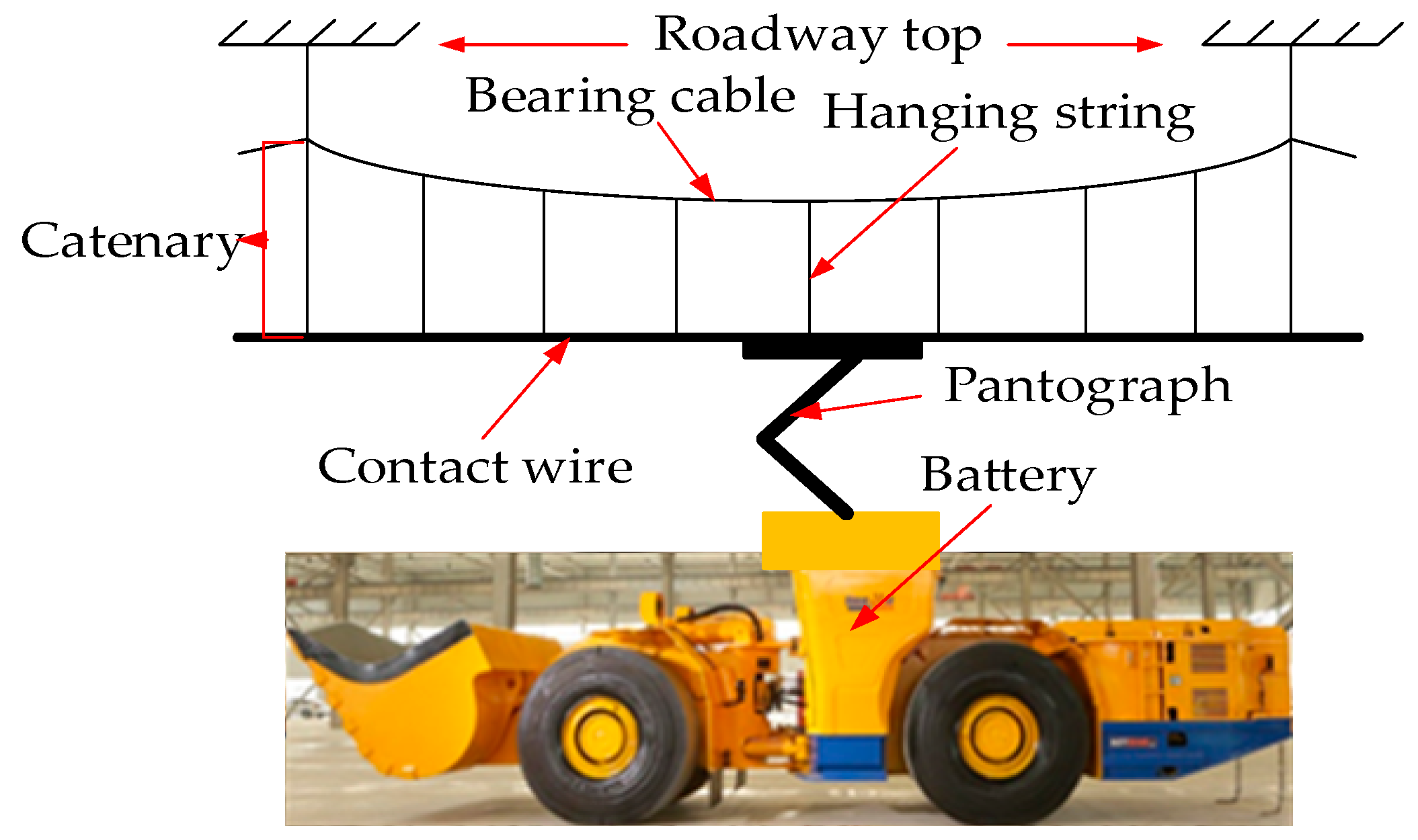


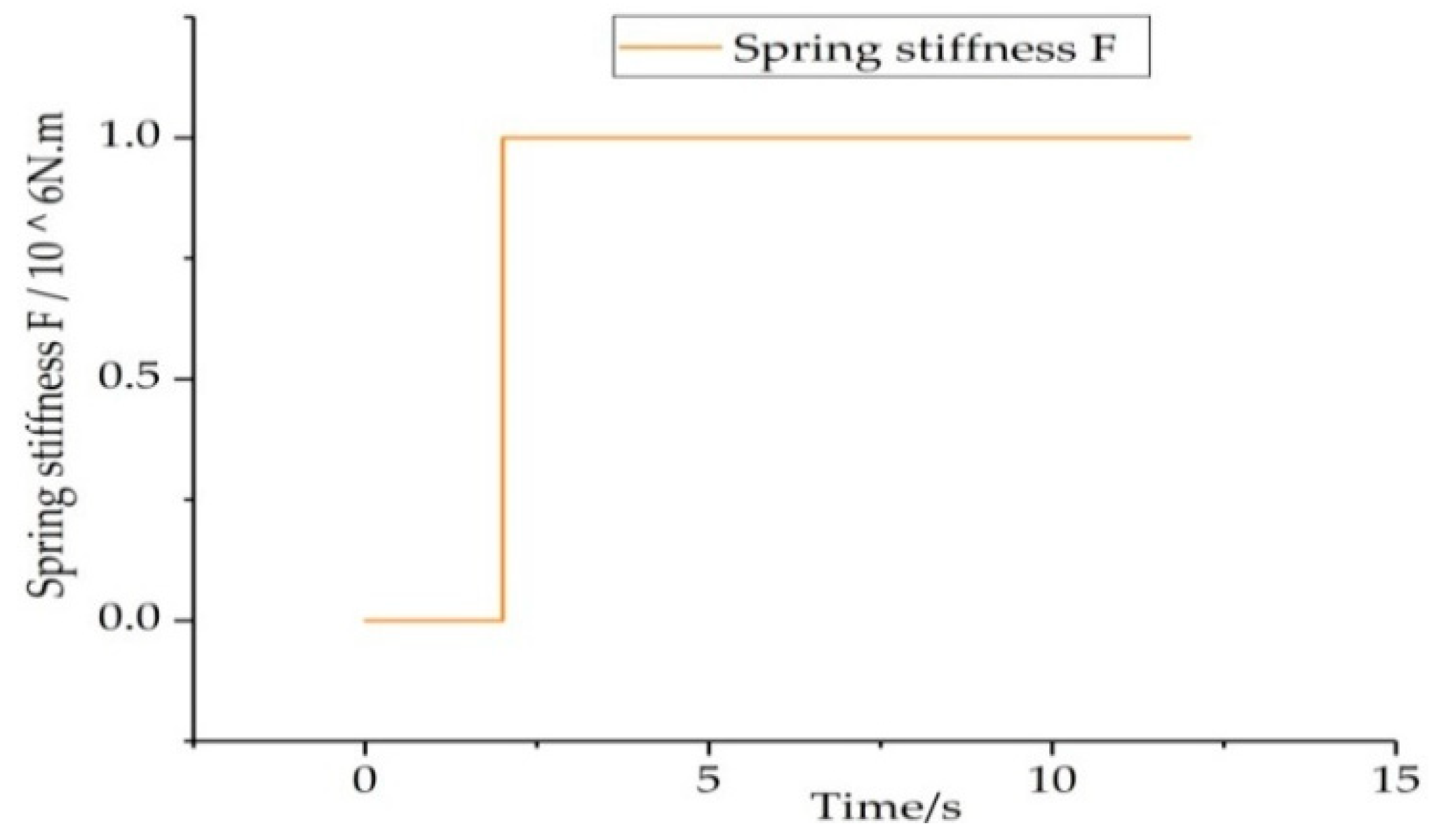

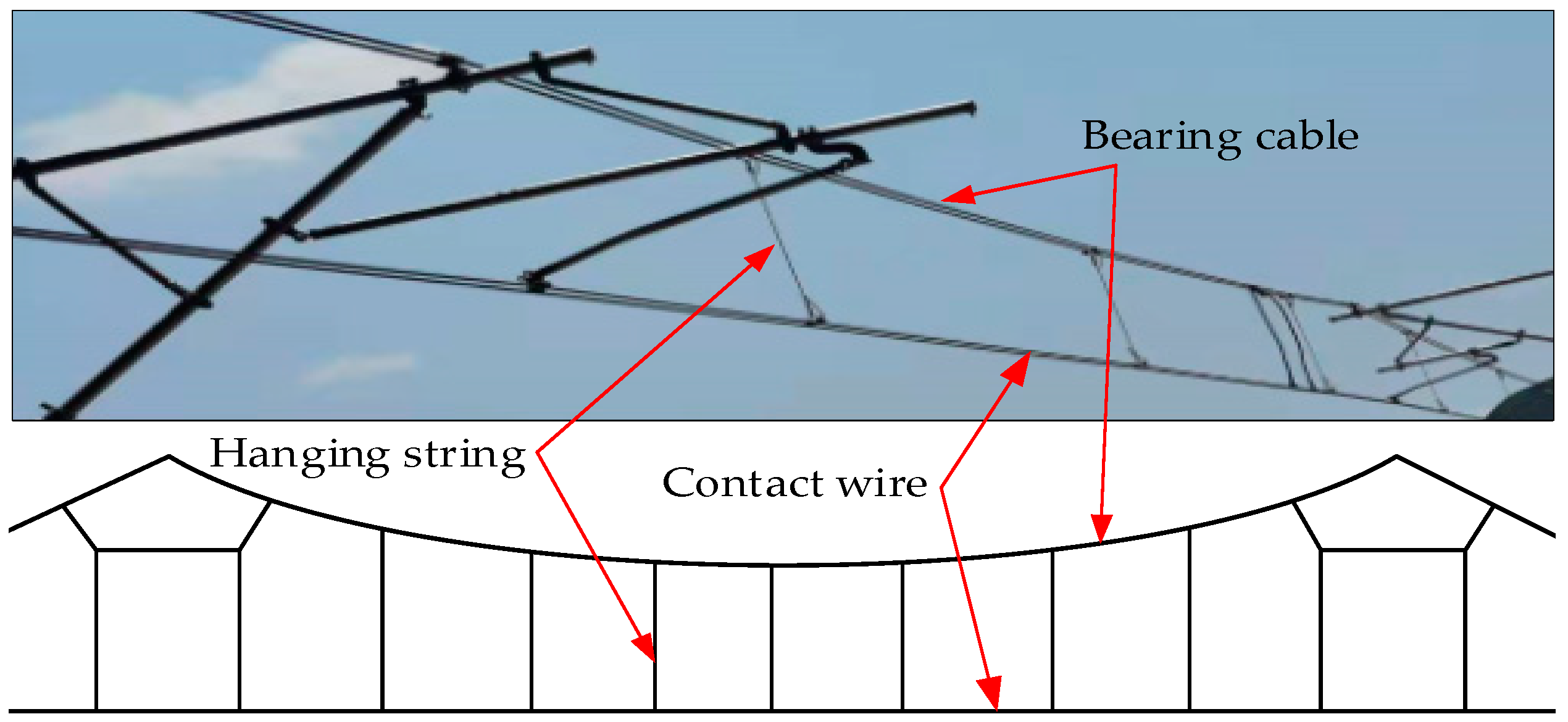
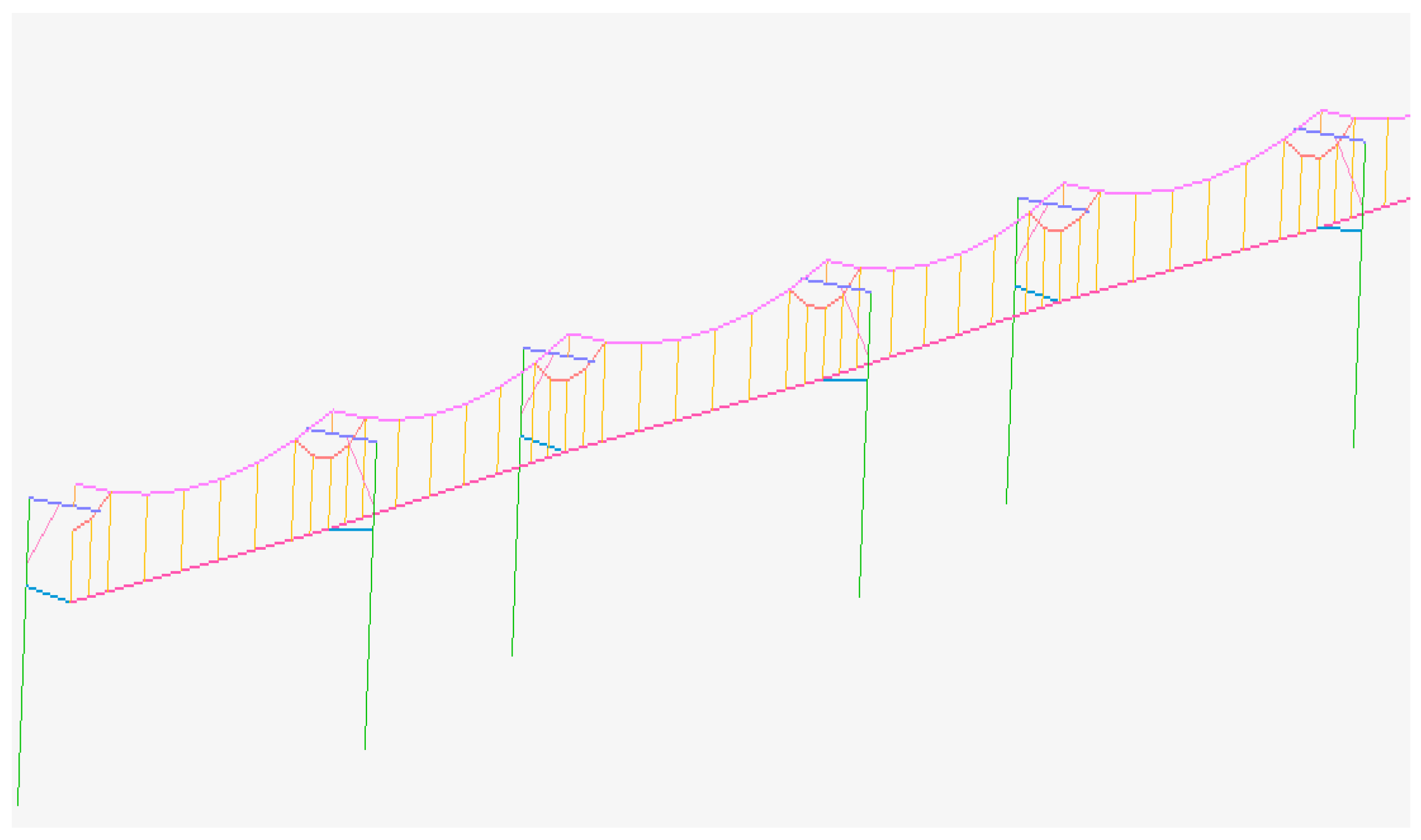
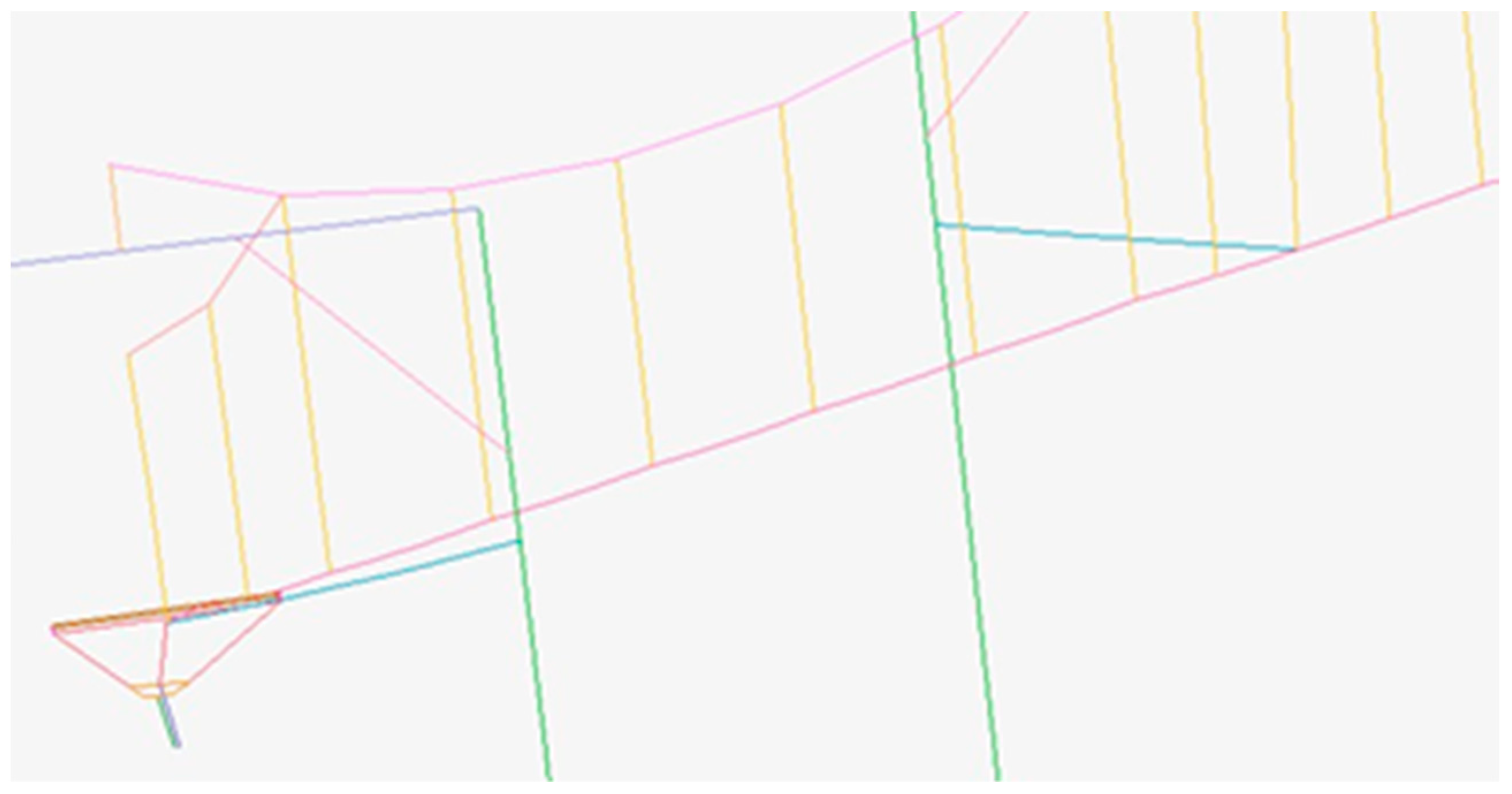
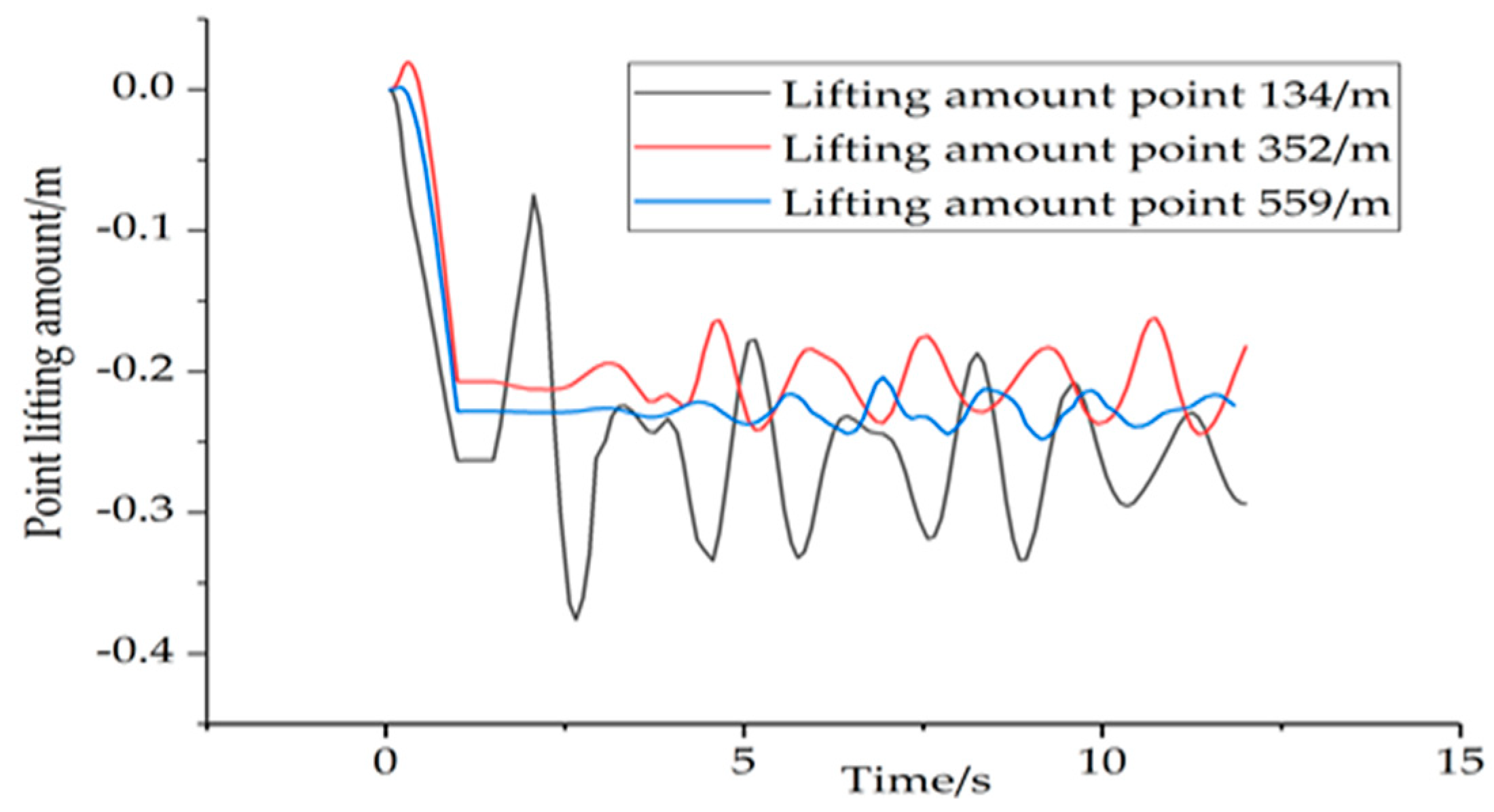
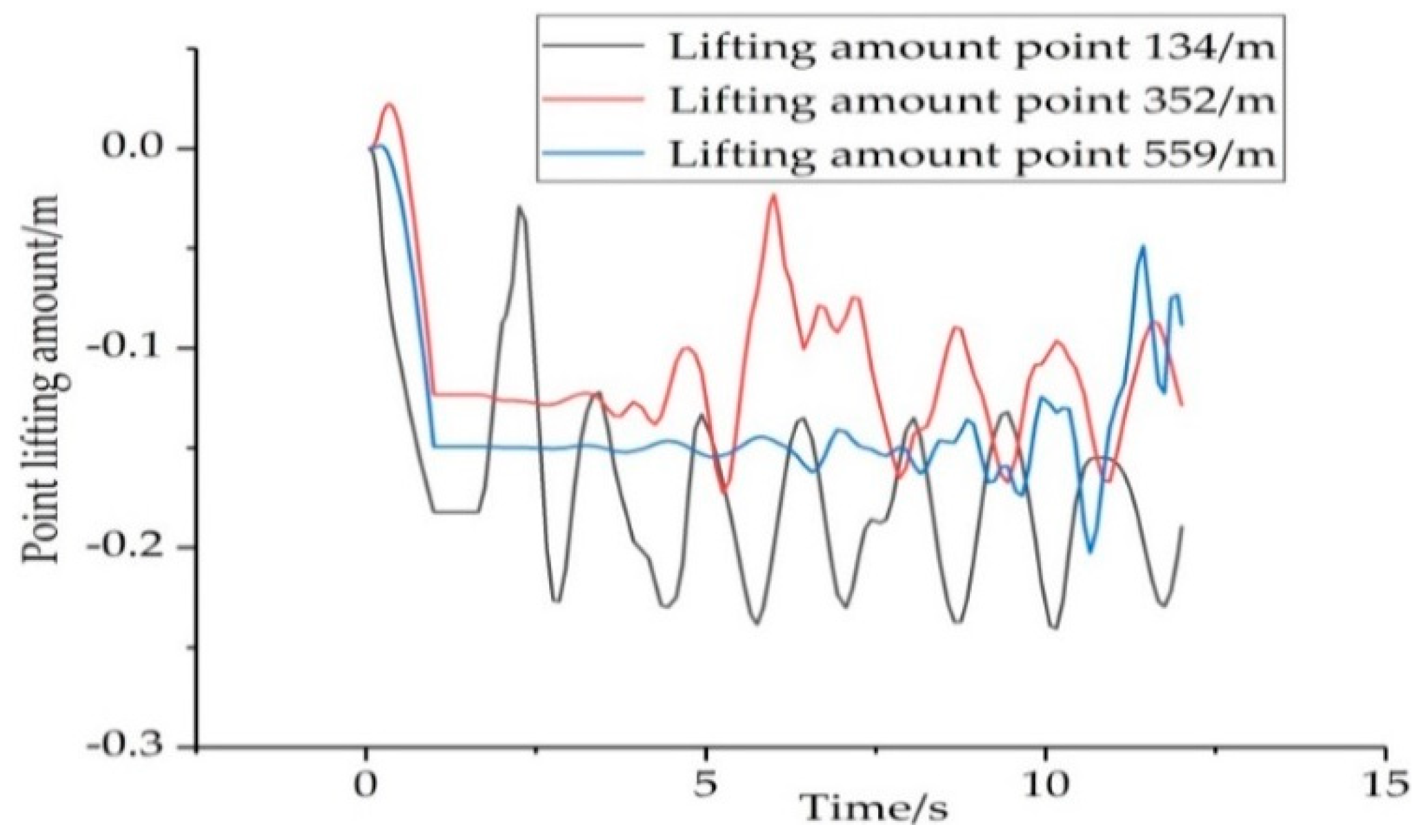
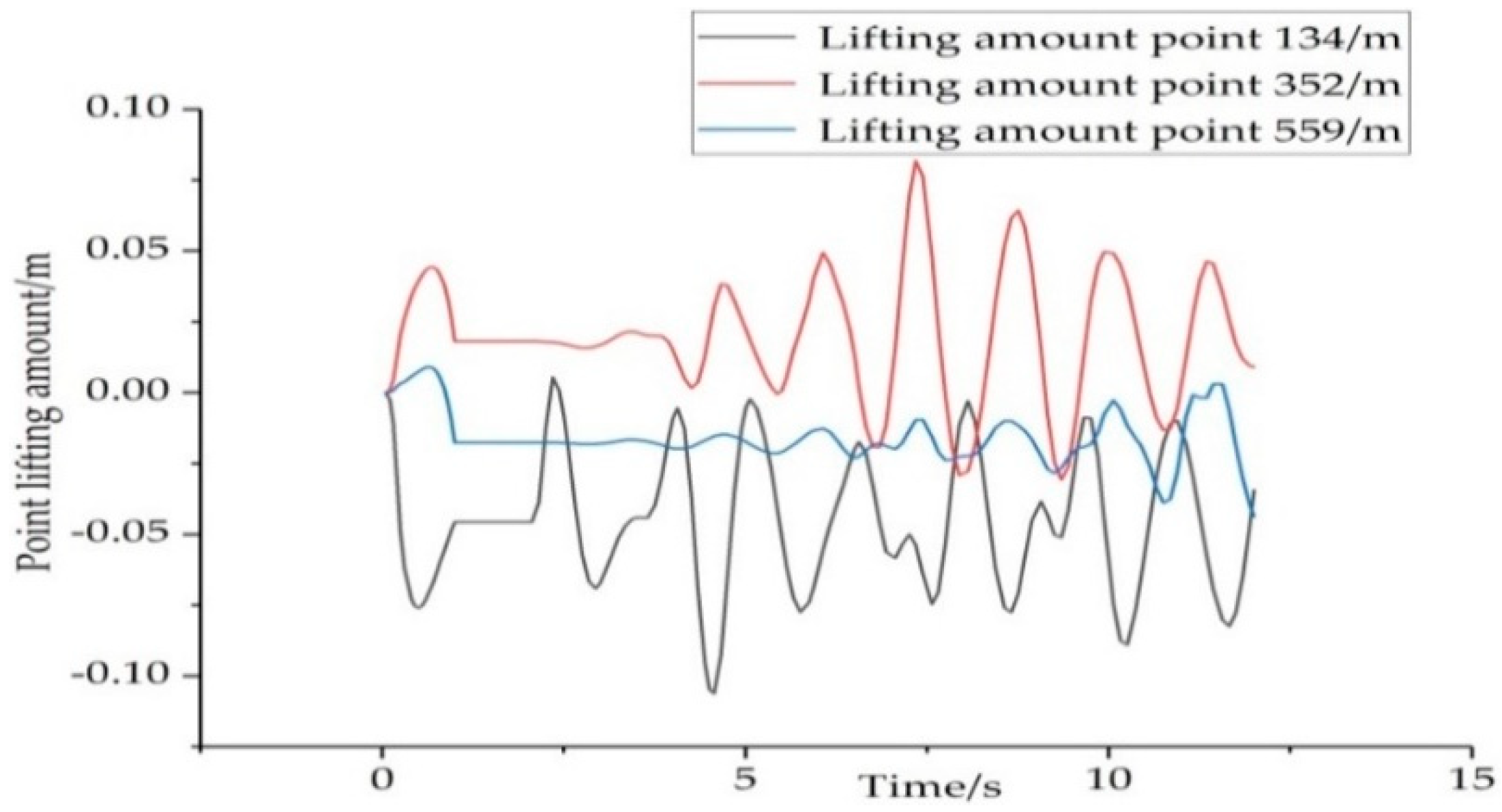
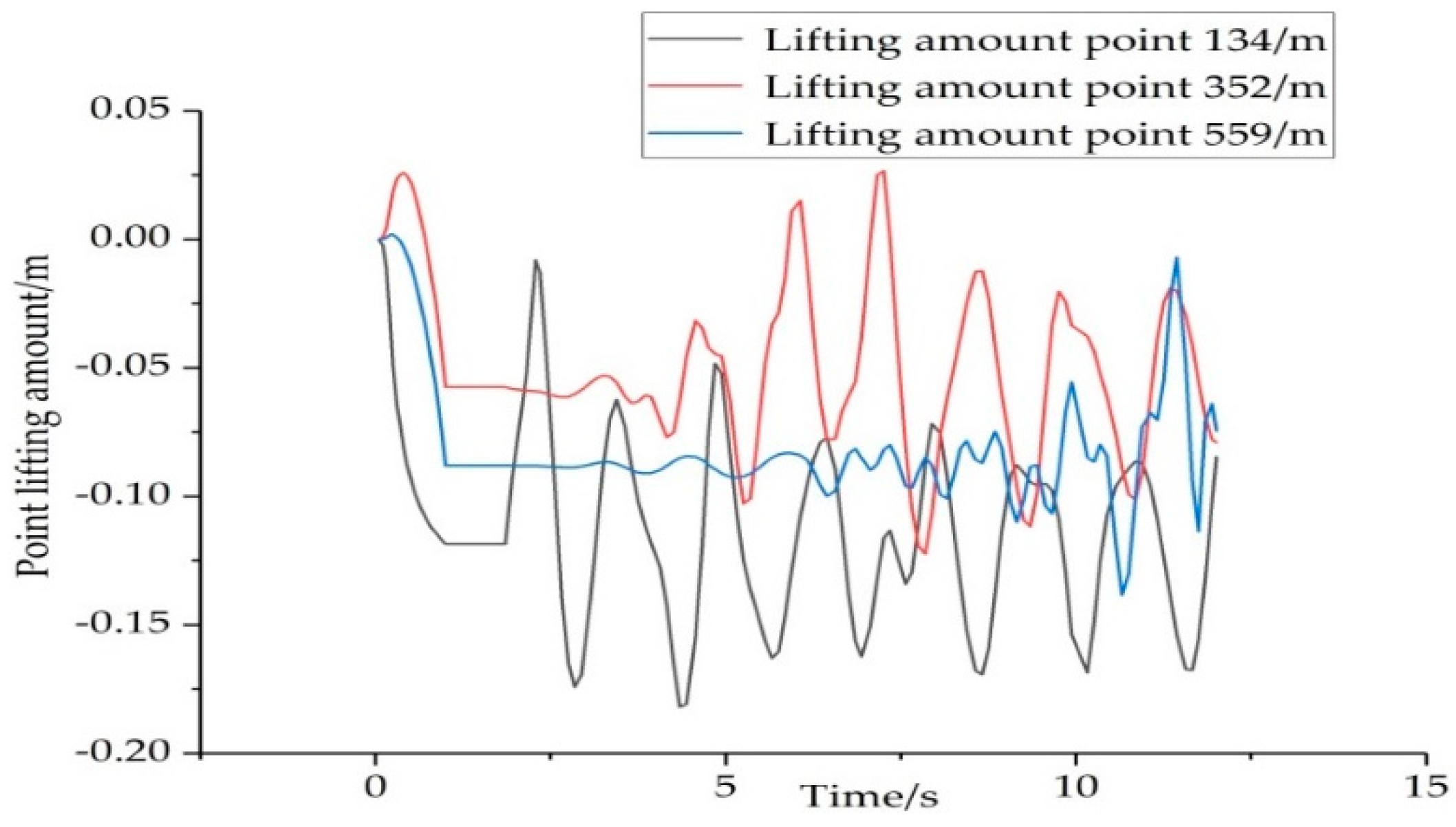

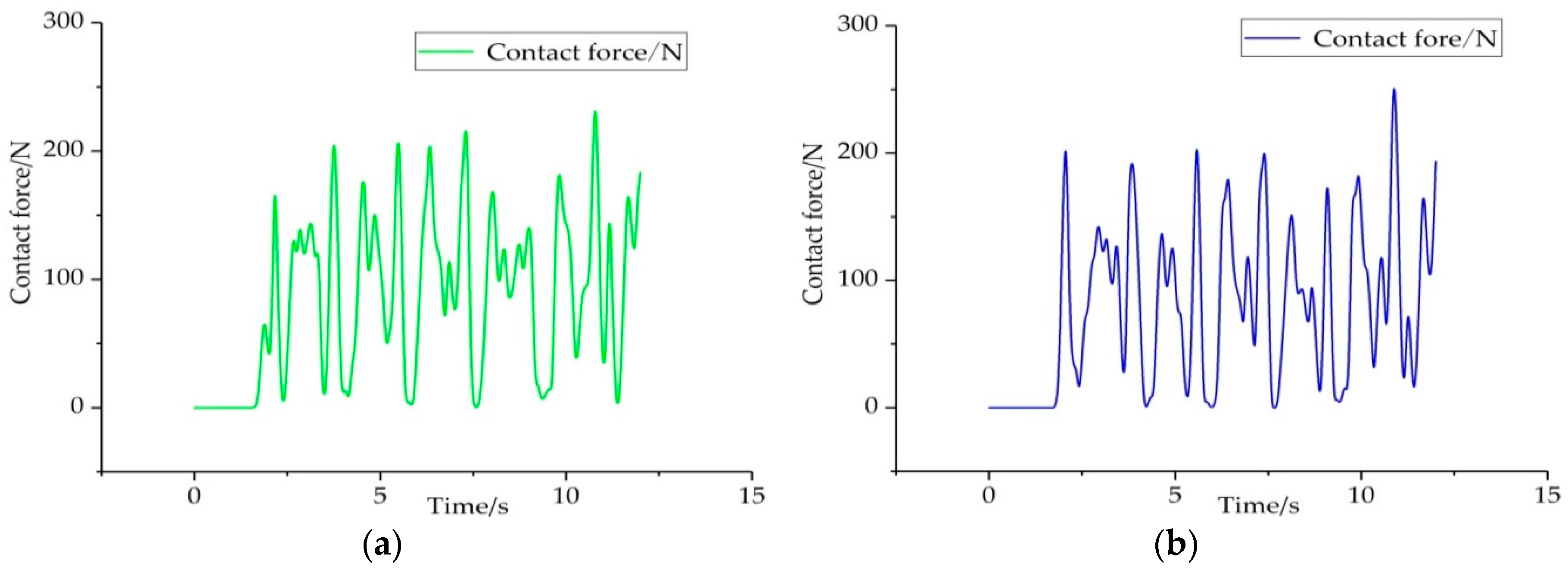

| Design Parameters | L1 | L2 | L3 | L4 | L5 | L6 | L7 | a | b | c | g |
|---|---|---|---|---|---|---|---|---|---|---|---|
| Parameter value | 1750 | 1800 | 230 | 1208 | 1750 | 1810 | 118 | 770 | 140 | 0.35 | 0.017 |
| Material | Carbon steel | Aluminum alloy | Carbon steel | Carbon steel | Car-bon steel | Aluminum alloy | Aluminum alloy | N/A | N/A | N/A | N/A |
| Component | Tensile Modulus/GPa | Poisson’s Ratio | Mass Density/(kg.mm−3) | Section Area | Material |
|---|---|---|---|---|---|
| Contact wire | 120 | 0.33 | 8900 | 150 | AgCu110 |
| Bearing cable | 120 | 0.33 | 8900 | 150 | JTMH120 |
| Hanging string | 120 | 0.33 | 8900 | 10 | Copper–magnesium alloy |
| Locator | 210 | 0.30 | 2700 | 2700 | Aluminum bronze |
| Inclined arm | 210 | 0.30 | 7850 | 5026 | Corrosion resistant steel |
| Contact wire Radius/m | Location Point | Lifting Amount Max | Lifting Amount Minimum | Lifting Amount Average |
|---|---|---|---|---|
| 0.00691 m | point 134 | 0.37602 | 0.00204 | 0.24825 |
| point 352 | 0.24479 | 0.09715 | 0.19841 | |
| point 559 | 0.24816 | 0.08873 | 0.21876 | |
| 0.00618 m | point 134 | 0.23830 | 0.07681 | 0.17269 |
| point 352 | 0.16807 | 0.03413 | 0.11200 | |
| point 559 | 0.20266 | 0.03286 | 0.13963 | |
| 0.00564 m | point 134 | 0.10695 | 0.03970 | 0.04552 |
| point 352 | 0.08209 | 0.01063 | 0.01944 | |
| point 559 | 0.04371 | 0.00913 | 0.01627 | |
| 0.00505 m | point 134 | 0.18359 | 0.10470 | 0.11400 |
| point 352 | 0.12300 | 0.05741 | 0.05127 | |
| point 559 | 0.13881 | 0.07636 | 0.08259 |
| Contact Wire Tension | Bearing Cable Tension 21 KN | |
|---|---|---|
| Maximum Offline Time/s | Offline Rate/% | |
| 29 KN | 0.1562 | 10.4% |
| 30 KN | 0.0625 | 5.21% |
| 31 KN | 0.2938 | 18.3% |
| 32 KN | 0.3438 | 19.1% |
| 33 KN | 0.4063 | 28.1% |
| 34 KN | 0.5000 | 35.5% |
© 2020 by the authors. Licensee MDPI, Basel, Switzerland. This article is an open access article distributed under the terms and conditions of the Creative Commons Attribution (CC BY) license (http://creativecommons.org/licenses/by/4.0/).
Share and Cite
Li, Y.; Jin, T.; Liu, L.; Yuan, K. Dynamic Performance Simulation and Stable Current Collection Analysis of a Pantograph Catenary System for Trolley Wire Overhead Electrically Actuated LHD. Energies 2020, 13, 1015. https://doi.org/10.3390/en13051015
Li Y, Jin T, Liu L, Yuan K. Dynamic Performance Simulation and Stable Current Collection Analysis of a Pantograph Catenary System for Trolley Wire Overhead Electrically Actuated LHD. Energies. 2020; 13(5):1015. https://doi.org/10.3390/en13051015
Chicago/Turabian StyleLi, Yinping, Tianxu Jin, Li Liu, and Kun Yuan. 2020. "Dynamic Performance Simulation and Stable Current Collection Analysis of a Pantograph Catenary System for Trolley Wire Overhead Electrically Actuated LHD" Energies 13, no. 5: 1015. https://doi.org/10.3390/en13051015
APA StyleLi, Y., Jin, T., Liu, L., & Yuan, K. (2020). Dynamic Performance Simulation and Stable Current Collection Analysis of a Pantograph Catenary System for Trolley Wire Overhead Electrically Actuated LHD. Energies, 13(5), 1015. https://doi.org/10.3390/en13051015




